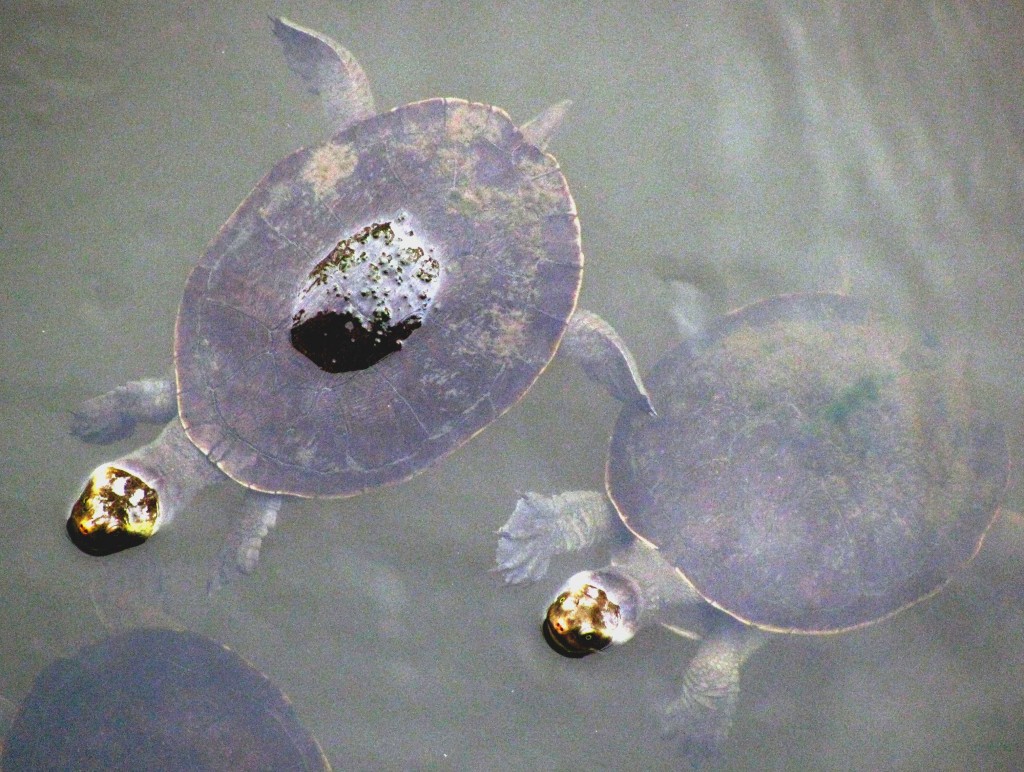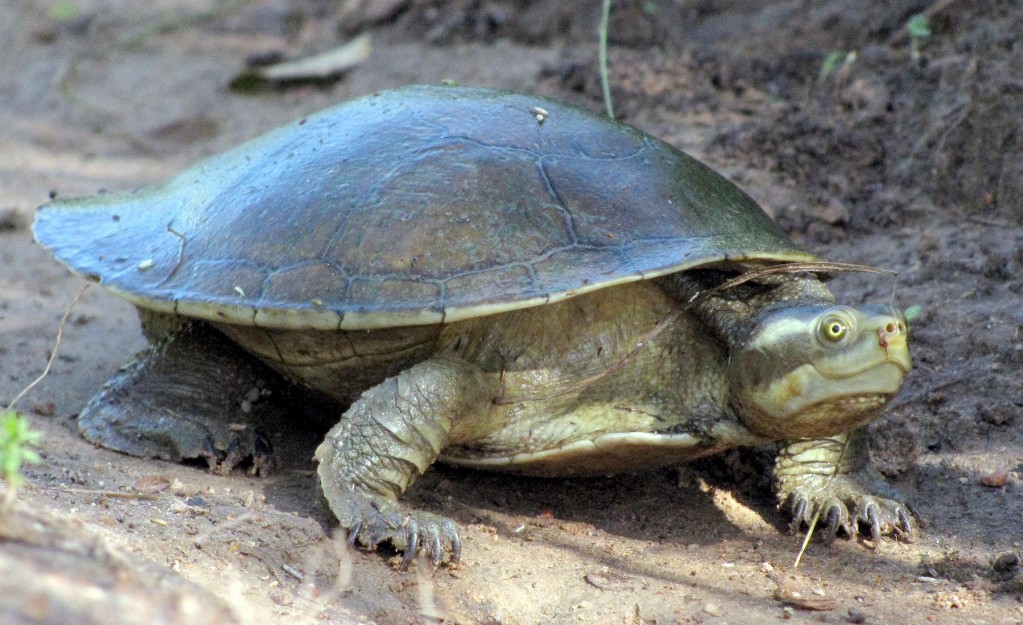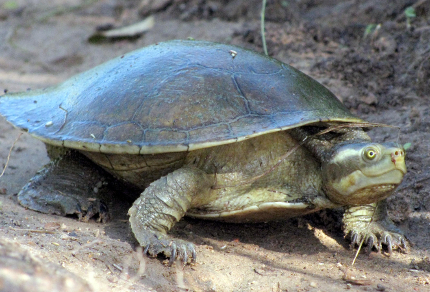A new feel pervaded the air this morning when I cycled into the Ross River Parkway, one of freshness and faint coolness, even at 8 a.m. A new crocodile warning sign – one of those permanent, yellow board signs attached to two posts pounded into the ground – was in place at the corner of Bowen Road and Tyack Street, replacing the white, temporary signs posted on trees on both sides of the bridge underpass on March 27. As well, I saw the street trees with new eyes, eyes widened through the perspective of our recent travels to Victoria and Tasmania. I still appreciated the rain trees, with their broad umbrella canopies, but my heart has been newly stolen by the slim, soaring mountain ashes of Yarrra Ranges National Park near Melbourne, and by the regal swamp gums of Mount Field and the Styx Valley of Tasmania. Maybe, I thought, I’m tree-fickle.

Krefft’s Turtles (© Magi Nams)
At the ‘Turtle Creek’ bridge near Palmetum Park, I paused to look for turtles and noted two women on the bridge, one of whom was edging along the outside of the bridge railing, and both of whom were definitely focussed on something in the water. Popping a quick look over the railing, I did spot a turtle, but not the tens of or, in one case at least a hundred, turtles I’d seen in the past. “There are some,” I commented, to which the older of the women nodded in agreement. “Are you studying the turtles?” I further inquired, noting that the women were holding lengths of cord.
“Yes. They seem to know.”
“What are you studying, about the turtles?”
Graciously accommodating this interruption in her work, the researher, whom I learned was Dr. Ellen Ariel of JCU’s School of Veterinary and Biomedical Sciences, explained that she was trying to capture some of the river turtles to take blood samples, with the aim of determining if the adult turtles have antibodies to a viral disease that’s present in frogs in the area. If the adult turtles have antibodies, it means they survived an infection by the virus. She provided me with her contact information and mentioned an upcoming international conference about frogs and diseases to be held at JCU in June.
The virus, I learned through following up on the information Dr. Ariel provided, is called the Bohle iridovirus. It’s endemic to Australia, and in the Townsville area has been isolated from ornate burrowing frogs1 and cane toads2, both of which Vilis and I have encountered in our explorations. The conference scheduled for June will focus on chytridiomycosis, the fungal disease that has devastated populations of frogs in Australia and in other countries around the world (see http://maginams.ca//2010/03/04/), but will also address amphibian diseases moving into the spotlight, one of which is the Bohle iridovirus.
My encounter with Dr. Ariel led me to wonder what kinds of turtles, other than Krefft’s turtle, occur in the Townsville area. Thus, I perused the turtle section of my reptile guide3 and a James Cook University webpage4 on local turtles, and dug out my notes from Vilis’s and my visit to the Reef HQ Aquarium. All these assisted me in gleaning the following information.
Two major groups of turtles inhabit the Townsville area – marine turtles and freshwater turtles. Within the marine group, my guide informed me that the coastal waters around Townsville lie within the range of five of the world’s seven species of sea turtles. These include the loggerhead, green, hawksbill, and flatback turtles, all of which are hard-shelled turtles, and the leathery turtle or leatherback.5 The range of the Pacific Ridley’s turtle comes close, so it may occasionally show up in local waters.6 With the exception of the huge leatherback, all these sea turtle species are about a metre long (the leatherback can reach 2.8 metres).5 Only the flatback turtle is a truly Australian sea turtle, as the others cruise the oceans of the world. 7
When we visited the Reef HQ Aquarium in January, Vilis and I sat in on a turtle talk and learned that all of Australia’s sea turtle species are endangered or severely endangered. Threats to their health and survival include polluted ocean waters, garbage that is sometimes mistaken for food (plastic bags resemble jellyfish to a sea turtle), boat strikes, entanglement in fishing nets or monofilament, and the destruction or light-pollution of beaches required for laying eggs. The Reef HQ Aquarium runs a hospital for injured or ill sea turtles and releases recovered patients back to the wild. Just today, I received a members’ newsletter from the aquarium which mentioned that two injured green turtles (one stranded on a beach after becoming entangled in fishing line, the other rescued from an undersea cave where it was wedged among rocks) were recently released back to the wild near Townsville.8

Krefft’s Turtle (© Vilis Nams)
Within the freshwater turtle group, Australia is inhabited by 28 species, including the introduced pest species, the red-eared slider.9 The native species generally fall into four groups – long-necked turtles, snapping turtles, short-necked turtles (all belonging to the same family, the Cheluidae), and pig-nosed turtle, the sole member of the family Carettochelydidae.10
The Krefft’s turtles I’ve seen so frequently in ‘Turtle Creek’ are short-necked turtles. Three other freshwater turtle species also occur in the Townsville area – the Cann’s or New Guinea long-necked turtle, a snapping turtle (the information I had didn’t jive regarding which species it is), and the saw-shelled turtle,4,11 none of which I have yet observed. The Cann’s long-necked turtle is listed as “near threatened,” but the other Townsville freshwater turtle species are apparently in good shape, since their descriptions included no reference to being threatened or endangered.11
The Cann’s long-necked turtle is an ambush hunter and uses its lengthy neck to help it launch strikes at tadpoles, fish, or crustaceans in the swamps and lagoons it inhabits.12 The saw-shelled turtle, whose carapace resembles a saw-blade on top, shares the long-neck’s carnivorous tendencies (can consume toxic cane toads), but also feeds on plants in creeks, swamps, and river tributaries.13 The Krefft’s turtle prefers to live in still waters, but isn’t picky about what it eats – plants, carrion, live invertebrates and small vertebrates.14 The snapping turtle, which has a horny shield on its head and a whitish face, feeds mostly on plants and is found in flowing water.15 All four of these species are much smaller than the marine turtles, ranging in length from 20 to 40 centimetres.11 With a sharper search image now and only a quartet of freshwater turtle species in the Townsville area, there’s a good chance I’ll be able to identify any I see in the future.
References:
1. R. Speare and J.R. Smith. 1992. An iridovirus-like agent isolated from the ornate burrowing frog Limnodynastes ornatus in northern Australia. Diseases of Aquatic 51-57.
2. R.J. Whittington, C. Kearns and R. Speare. 1997. Detection of antibodies against iridoviruses in the serum of the amphibian Bufo marinus. Journal of Virological Methods 68(1):105-108.
3. Steve Wilson and Gerry Swan. 2008. A Complete Guide to the Reptiles of Australia. New Holland Publishers (Australia) Pty. Ltd. Sydney. pp. 24-52.
4. James Cook University. 1995-2008. Turtles of Townsville. Published 27-Nov-2006. Accessed 7-Apr-2010. URL: http://www.jcu.edu.au/school/tbiol/zoology/herp/TownsvilleHerps/TsvlHerps-turtles.shtml
5. Wilson and Swan, p. 26, 28; 6. Ibid, p. 28; 7. Ibid, p. 24.
8. Reef HQ Great Barrier Reef Aquarium. Autumn 2010. Members Newsletter. 2 p.
9. Wilson and Swan, p. 32, 50, 52; 10. Ibid, pp. 32, 34, 36, 50; 11. Ibid, p. 34, 38, 42, 48; 12. Ibid, p. 34; 13. Ibid, p. 48; 14. Ibid, p. 42; 15. Ibid, p. 38.


